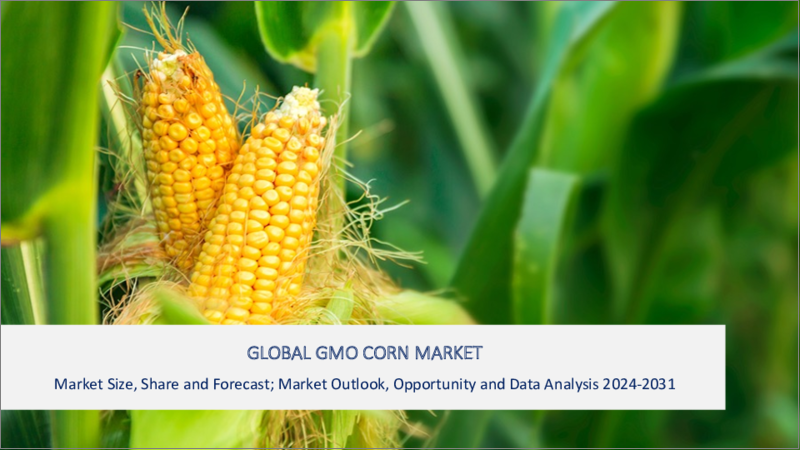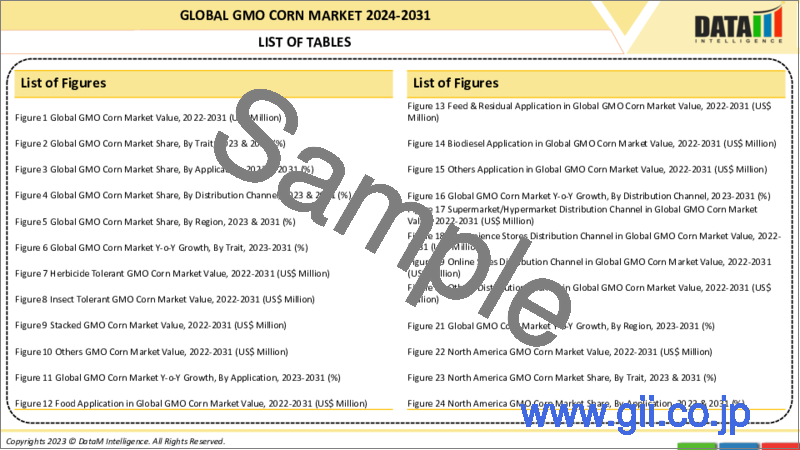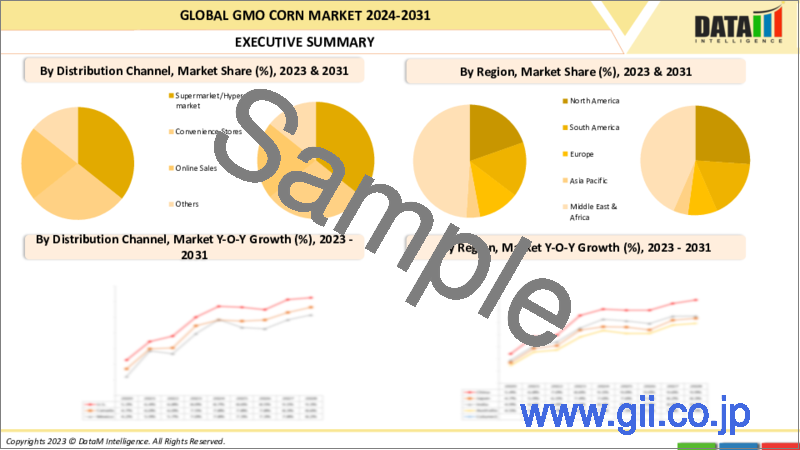|
|
市場調査レポート
商品コード
1304573
遺伝子組み換えトウモロコシの世界市場-2023年~2030年Global GMO Corn Market - 2023-2030 |
||||||
カスタマイズ可能
適宜更新あり
|
|||||||
| 遺伝子組み換えトウモロコシの世界市場-2023年~2030年 |
|
出版日: 2023年07月07日
発行: DataM Intelligence
ページ情報: 英文 190 Pages
納期: 即日から翌営業日
|
- 全表示
- 概要
- 目次
市場概要
遺伝子組み換えトウモロコシの世界市場は、2022年に2,601億米ドルに達し、2030年には3,842億米ドルに達すると予測され、予測期間2023-2030年のCAGRは5.0%で成長すると予測されています。遺伝子組換え除草剤耐性トウモロコシ品種の採用増加が、遺伝子組換えトウモロコシ市場の顕著な動向です。モンサント社のラウンドアップ対応トウモロコシの栽培が広まったことで、農家はグリホサートベースの除草剤を使用して雑草を効果的に防除できるようになっています。
遺伝子組み換えトウモロコシ市場は、遺伝子組み換えトウモロコシ品種の栽培と取引を特徴とする、農業業界内の盛んなセクターです。これらの品種は、昆虫抵抗性、除草剤耐性、収量増加の可能性など、望ましい形質を持つように遺伝子工学技術によって開発されています。この市場を牽引しているのは、世界の食糧需要の増大、バイオテクノロジーの進歩、持続可能な農業実践の必要性といった要因です。
持続可能な農業慣行に対する需要の高まりが、遺伝子組み換えトウモロコシ市場を大きく牽引しています。例えば、Btトウモロコシのような遺伝子組換え耐虫性トウモロコシ品種の採用は、農薬の使用を減らし、害虫による作物の損失を最小限に抑えようとする農家の間で勢いを増しています。この原動力は、害虫管理と持続可能な作物生産を促進する、環境に優しいソリューションの開発に業界が注力していることを反映しています。
市場力学
食糧安全保障に対する意識の高まりが遺伝子組み換えトウモロコシ市場の成長を促進する
食糧安全保障に対する意識の高まりは、遺伝子組み換えトウモロコシ市場の成長促進要因のひとつです。食料安全保障とは、すべての個人がいつでも食料を入手でき、利用しやすく、手頃な価格で購入できることと定義されます。人口の増加と耕地や水資源の限られた利用可能性とが相まって、増加する人口の需要を満たすのに十分な食糧を生産することが困難になっています。
そのため、より生産性が高く、病害虫に強く、環境ストレスに強い作物の開発への関心が高まっています。遺伝子組み換えトウモロコシは、収量を増やし、病害虫による作物の損失を減らし、干ばつや暑さなどの環境ストレスに対する作物の耐性を向上させることで、こうした課題に対処するのに役立ちます。これらの利点は食糧増産につながり、食糧安全保障の向上と、増加する人口に対する安定した食糧供給の確保に役立っています。
気候変動がレジリエントな作物ソリューションへの需要を促進し、遺伝子組み換えトウモロコシ市場は繁栄する
気候変動に直面した作物の回復力に対するニーズの高まりが、遺伝子組み換えトウモロコシ市場の動向を後押ししています。従来の作物栽培は、予測不可能な天候パターンや新興の病害虫による課題に直面しています。干ばつ耐性、耐暑性、耐病性を備えた遺伝子組み換えトウモロコシ品種は、不利な気候条件に耐えることができます。
回復力のある作物を開発することの重要性を認識し、遺伝子組み換えトウモロコシ市場は導入の急増を目の当たりにしています。農家は気候変動リスクを軽減し、安定した食料生産を確保するために、遺伝子組み換えトウモロコシを利用するようになってきています。遺伝子組換え形質を組み込むことで、変化する環境条件によりよく適応し、農業収量を守ることができます。
遺伝子組み換えトウモロコシの環境影響に対する懸念の高まりが市場成長の妨げに
遺伝子組み換えトウモロコシの環境への影響に関する懸念は、遺伝子組み換えトウモロコシ市場の成長を抑制する可能性があります。遺伝子組み換えトウモロコシは、しばしばグリホサートなどの除草剤に耐性を持つように設計されており、生物多様性の喪失につながる可能性があります。除草剤は在来の植物を枯らしてしまうため、生態系に波及し、野生生物や昆虫の個体数に影響を与える可能性があります。遺伝子組み換えトウモロコシの遺伝子が、野生の近縁種を含む他の植物に移り、新たな雑草を生み出したり、その他の予期せぬ結果をもたらすことが懸念されます。
遺伝子組み換えトウモロコシの品種の中には、BT毒素のような独自の農薬を生産するように遺伝子組み換えされたものもあり、対象となる害虫に抵抗性を発達させる可能性があります。その結果、農薬の使用量を増やす必要が生じ、環境に悪影響を及ぼす可能性があります。遺伝子組み換え作物の使用を含む集約的な農法は、土壌の劣化、浸食、肥沃度の低下につながる可能性があります。これは土壌の健全性と生産性に長期的な悪影響を及ぼす可能性があります。
COVID-19影響分析
COVID-19分析には、COVID前シナリオ、COVIDシナリオ、COVID後シナリオに加え、価格力学(COVID前シナリオと比較したパンデミック中およびパンデミック後の価格変動を含む)、需給スペクトラム(取引制限、封鎖、およびその後の問題による需要と供給のシフト)、政府の取り組み(政府機関による市場、セクター、産業を活性化するための取り組み)、メーカーの戦略的取り組み(COVID問題を緩和するためにメーカーが行ったことをここで取り上げる)が含まれます。
目次
第1章 調査手法と調査範囲
第2章 市場の定義と概要
第3章 エグゼクティブサマリー
第4章 市場力学
- 市場への影響要因
- 促進要因
- 抑制要因
- 機会
- 影響分析
第5章 産業分析
- ポーターのファイブフォース分析
- サプライチェーン分析
- 価格分析
- 規制分析
第6章 COVID-19分析
第7章 形質別
- 除草剤耐性
- 昆虫耐性
- 積み重ね型
- その他
第8章 用途別
- 食品
- 飼料・残渣
- バイオディーゼル
- その他
第9章 流通チャネル別
- スーパーマーケット/ハイパーマーケット
- コンビニエンスストア
- オンライン販売
- その他
第10章 地域別
- 北米
- 米国
- カナダ
- メキシコ
- 欧州
- ドイツ
- 英国
- フランス
- イタリア
- スペイン
- その他欧州
- 南米
- ブラジル
- アルゼンチン
- その他南米
- アジア太平洋
- 中国
- インド
- 日本
- オーストラリア
- その他アジア太平洋地域
- 中東・アフリカ
第11章 競合情勢
- 競合シナリオ
- 市況/シェア分析
- M&A分析
第12章 企業プロファイル
- BASF SE
- 会社概要
- 製品ポートフォリオと説明
- 財務概要
- 主な発展
- Bayer AG
- Syngenta AG
- Bayer CropScience
- DowDupont
- Groupe Limagrain
- AgReliant Genetics, LLC
- CANTERRA SEEDS
- Dow AgroSciences LLC
- The Monsanto Company
第13章 付録
Market Overview
The Global GMO Corn Market reached US$ 260.1 billion in 2022 and is expected to reach US$ 384.2 billion by 2030 and is expected to grow with a CAGR of 5.0% during the forecast period 2023-2030. Increasing adoption of genetically modified herbicide-tolerant corn varieties is a prominent trend in the GMO corn market. The widespread cultivation of Monsanto's roundup-ready corn has enabled farmers to effectively control weeds by using glyphosate-based herbicides.
The GMO Corn Market is a thriving sector within the agriculture industry, characterized by the cultivation and trade of genetically modified corn varieties. These varieties have been developed through genetic engineering techniques to possess desired traits such as insect resistance, herbicide tolerance, and increased yield potential. The market is driven by factors such as growing global food demand, advancements in biotechnology, and the need for sustainable agricultural practices.
Growing demand for sustainable agriculture practices significantly drives the GMO corn market. For instance, the adoption of genetically modified insect resistant corn varieties, such as Bt corn, has gained momentum among farmers seeking to reduce pesticide use and minimize crop losses caused by pests. This driver reflects the industry's focus on developing environmentally friendly solutions that promote pest management and sustainable crop production.
Market Dynamics
Increasing Awareness of Food Security is Driving the GMO Corn Market Growth
The rising awareness of food security is one of the key drivers of the GMO corn market growth. Food security is defined as the availability, accessibility, and affordability of food for all individuals at all times. The increasing population, coupled with the limited availability of arable land and water resources, has made it challenging to produce enough food to meet the demand of a growing population.
This has led to an increased interest in developing crops that are more productive, resistant to pests and diseases, and tolerant to environmental stresses. GMO corn can help to address these challenges by increasing yields, reducing crop losses due to pests and diseases, and improving crop resilience to environmental stresses such as drought and heat. These benefits can lead to increased food production, which can help to improve food security and ensure a stable food supply for the growing population.
GMO Corn Market Thrives as Climate Change Drives Demand for Resilient Crop Solutions
The increasing need for crop resilience in the face of climate change drives the GMO corn market trend. Traditional crop cultivation faces challenges due to unpredictable weather patterns and emerging pests and diseases. GMO corn varieties engineered for drought tolerance, heat resistance, and disease resistance enable them to withstand adverse climatic conditions.
Recognizing the importance of developing resilient crops, the GMO corn market is witnessing a surge in adoption. Farmers are increasingly turning to GMO corn to mitigate climate change risks and ensure stable food production. By incorporating genetically modified traits, they can better adapt to changing environmental conditions and safeguard their agricultural yields.
Rising Concerns About the Environmental Impact of GMO Corn Hamper the Market Growth
Concerns about the environmental impact of GMO corn can restrain the growth of the GMO corn market. GMO corn is often engineered to be resistant to herbicides, such as glyphosate, which can lead to the loss of biodiversity. Herbicides can kill off native plants, which can have a ripple effect on the ecosystem, affecting wildlife and insect populations. There is a concern that the genes from GMO corn can transfer to other plants, including wild relatives, which could create new weeds or other unintended consequences.
Some GMO corn varieties have been engineered to produce their own pesticides, such as the BT toxin, which can lead to the development of resistance in target pests. This can create a need for higher pesticide use, which can have negative environmental impacts. Intensive farming practices, including the use of GMO crops, can lead to soil degradation, erosion, and loss of fertility. This can have long-term negative impacts on soil health and productivity.
COVID-19 Impact Analysis
The COVID-19 Analysis includes Pre-COVID Scenario, COVID Scenario, and Post-COVID Scenario along with Pricing Dynamics (Including pricing change during and post-pandemic comparing it to pre-COVID scenarios), Demand-Supply Spectrum (Shift in demand and supply owing to trading restrictions, lockdown, and subsequent issues), Government Initiatives (Initiatives to revive market, sector or Industry by Government Bodies) and Manufacturers Strategic Initiatives (What manufacturers did to mitigate the COVID issues will be covered here).
Segment Analysis
The Global GMO Corn Market is segmented based on the trait, application, distribution channel, and region.
Feed & Residual Segment Dominates the GMO Corn Market, Fueled by Rising Demand for Animal Protein and Livestock Feed Production
Based on application, GMO corn is divided into food, feed & residual, biodiesel, and others. The feed & residual segment holds a 45% share of the GMO corn market. The global demand for animal protein is increasing, particularly in developing countries, where rising incomes and population growth are driving an increase in demand for meat, dairy, and eggs.
As a result, there is a growing demand for animal feed, primarily from corn, soybean, and other grains. GMO corn has been developed to have higher yields and better resistance to pests and diseases, making it an attractive crop for animal feed production. GMO corn has been engineered to have improved nutritional qualities, such as higher levels of protein and essential amino acids.
This makes GMO corn a more suitable crop for animal feed, as it can help to meet the nutritional needs of livestock and improve their health and growth. As per CropLife, about 70% of harvested crops such as corn. Soybean etc. are taken as animal feed which represents that the livestock populations are the major consumers of GMO crops. Hence, the growing demand for animal feed has made it have the highest share in the GMO corn market.
Geographical Analysis
Asia Pacific Emerges as the Fastest-Growing Market for GMO Corn
The Global GMO Corn Market is segmented by region into North America, South America, Europe, Asia-Pacific, Middle-east, and Africa.
The Asia Pacific GMO corn market is a rapidly growing region in the global market. The increasing demand for corn-based food products has been one of the factors driving the growth of the GMO corn market share in the Asia Pacific region. The growing population and changing dietary habits in the region have increased demand for corn-based food products such as breakfast cereals, snack foods, and processed foods.
For instance, as per Statista, in 2021-22 the consumption of Genetically Modified Organism (GMO) corn in China is 11.57 billion bushels. Genetically Modified (GM) corn, developed through biotechnology, genetic modification techniques, and genetic engineering techniques, has been successful in increasing yields, reducing susceptibility to pests and diseases, and enhancing the nutritional content of corn.
These benefits have made GMO corn, also known as Transgenic Corn, an attractive option for farmers and food manufacturers in the Asia Pacific region. As a result, the GMO corn market in the Asia Pacific region, driven by GM technology and biotechnology advancements, has experienced significant growth in recent years, with countries such as China, India, and the Philippines emerging as key producers and consumers of GMO corn.
Competitive Landscape
The major global players include: BASF SE, Bayer AG, Syngenta AG, Bayer CropScience, DowDupont, Groupe Limagrain, AgReliant Genetics, LLC, CANTERRA SEEDS, Dow AgroSciences LLC, and The Monsanto Company.
Why Purchase the Report?
- To visualize the Global GMO Corn Market segmentation based on the trait, application, distribution channel, and region and understand key commercial assets and players.
- Identify commercial opportunities in the market by analyzing trends and co-development.
- Excel data sheet with numerous data points of GMO Corn market-level with all segments.
- The PDF report consists of a comprehensive market analysis after exhaustive qualitative interviews and an in-depth market study.
- Product mapping is available as Excel consists of key products of all the major market players.
The Global GMO Corn Market Report Would Provide Approximately 61 Tables, 60 Figures And 190 Pages.
Target Audience 2023
- Manufacturers/ Buyers
- Industry Investors/Investment Bankers
- Research Professionals
- Emerging Companies
Table of Contents
1. Methodology and Scope
- 1.1. Research Methodology
- 1.2. Research Objective and Scope of the Report
2. Market Definition and Overview
3. Executive Summary
- 3.1. Snippet by Trait
- 3.2. Snippet by Application
- 3.3. Snippet by Distribution Channel
- 3.4. Snippet by Region
4. Market Dynamics
- 4.1. Market Impacting Factors
- 4.1.1. Drivers
- 4.1.2. Restraints
- 4.1.3. Opportunity
- 4.1.4. Impact Analysis
5. Industry Analysis
- 5.1. Porter's Five Force Analysis
- 5.2. Supply Chain Analysis
- 5.3. Pricing Analysis
- 5.4. Regulatory Analysis
6. COVID-19 Analysis
- 6.1. Analysis of COVID-19 on the Market
- 6.1.1. Scenario Before COVID-19
- 6.1.2. Scenario During COVID-19
- 6.1.3. Scenario Post COVID-19
- 6.2. Pricing Dynamics Amid COVID-19
- 6.3. Demand-Supply Spectrum
- 6.4. Government Initiatives Related to the Market During the Pandemic
- 6.5. Manufacturer's Strategic Initiatives
- 6.6. Conclusion
7. By Trait
- 7.1. Introduction
- 7.1.1. Market Size Analysis and Y-o-Y Growth Analysis (%), By Trait
- 7.1.2. Market Attractiveness Index, By Trait
- 7.2. Herbicide Tolerant*
- 7.2.1. Introduction
- 7.2.2. Market Size Analysis and Y-o-Y Growth Analysis (%)
- 7.3. Insect Tolerant
- 7.4. Stacked
- 7.5. Others
8. By Application
- 8.1. Introduction
- 8.1.1. Market Size Analysis and Y-o-Y Growth Analysis (%), By Application
- 8.1.2. Market Attractiveness Index, By Application
- 8.2. Food*
- 8.2.1. Introduction
- 8.2.2. Market Size Analysis and Y-o-Y Growth Analysis (%)
- 8.3. Feed & Residual
- 8.4. Biodiesel
- 8.5. Others
9. By Distribution Channel
- 9.1. Introduction
- 9.1.1. Market Size Analysis and Y-o-Y Growth Analysis (%), By Distribution Channel
- 9.1.2. Market Attractiveness Index, By Distribution Channel
- 9.2. Supermarket/Hypermarket*
- 9.2.1. Introduction
- 9.2.2. Market Size Analysis and Y-o-Y Growth Analysis (%)
- 9.3. Convenience Stores
- 9.4. Online Sales
- 9.5. Others
10. By Region
- 10.1. Introduction
- 10.1.1. Market Size Analysis and Y-o-Y Growth Analysis (%), By Region
- 10.1.2. Market Attractiveness Index, By Region
- 10.2. North America
- 10.2.1. Introduction
- 10.2.2. Key Region-Specific Dynamics
- 10.2.3. Market Size Analysis and Y-o-Y Growth Analysis (%), By Trait
- 10.2.4. Market Size Analysis and Y-o-Y Growth Analysis (%), By Application
- 10.2.5. Market Size Analysis and Y-o-Y Growth Analysis (%), By Distribution Channel
- 10.2.6. Market Size Analysis and Y-o-Y Growth Analysis (%), By Country
- 10.2.6.1. The U.S.
- 10.2.6.2. Canada
- 10.2.6.3. Mexico
- 10.3. Europe
- 10.3.1. Introduction
- 10.3.2. Key Region-Specific Dynamics
- 10.3.3. Market Size Analysis and Y-o-Y Growth Analysis (%), By Trait
- 10.3.4. Market Size Analysis and Y-o-Y Growth Analysis (%), By Application
- 10.3.5. Market Size Analysis and Y-o-Y Growth Analysis (%), By Distribution Channel
- 10.3.6. Market Size Analysis and Y-o-Y Growth Analysis (%), By Country
- 10.3.6.1. Germany
- 10.3.6.2. The UK
- 10.3.6.3. France
- 10.3.6.4. Italy
- 10.3.6.5. Spain
- 10.3.6.6. Rest of Europe
- 10.4. South America
- 10.4.1. Introduction
- 10.4.2. Key Region-Specific Dynamics
- 10.4.3. Market Size Analysis and Y-o-Y Growth Analysis (%), By Trait
- 10.4.4. Market Size Analysis and Y-o-Y Growth Analysis (%), By Application
- 10.4.5. Market Size Analysis and Y-o-Y Growth Analysis (%), By Distribution Channel
- 10.4.6. Market Size Analysis and Y-o-Y Growth Analysis (%), By Country
- 10.4.6.1. Brazil
- 10.4.6.2. Argentina
- 10.4.6.3. Rest of South America
- 10.5. Asia-Pacific
- 10.5.1. Introduction
- 10.5.2. Key Region-Specific Dynamics
- 10.5.3. Market Size Analysis and Y-o-Y Growth Analysis (%), By Trait
- 10.5.4. Market Size Analysis and Y-o-Y Growth Analysis (%), By Application
- 10.5.5. Market Size Analysis and Y-o-Y Growth Analysis (%), By Distribution Channel
- 10.5.6. Market Size Analysis and Y-o-Y Growth Analysis (%), By Country
- 10.5.6.1. China
- 10.5.6.2. India
- 10.5.6.3. Japan
- 10.5.6.4. Australia
- 10.5.6.5. Rest of Asia-Pacific
- 10.6. Middle East and Africa
- 10.6.1. Introduction
- 10.6.2. Key Region-Specific Dynamics
- 10.6.3. Market Size Analysis and Y-o-Y Growth Analysis (%), By Trait
- 10.6.4. Market Size Analysis and Y-o-Y Growth Analysis (%), By Application
- 10.6.5. Market Size Analysis and Y-o-Y Growth Analysis (%), By Distribution Channel
11. Competitive Landscape
- 11.1. Competitive Scenario
- 11.2. Market Positioning/Share Analysis
- 11.3. Mergers and Acquisitions Analysis
12. Company Profiles
- 12.1. BASF SE*
- 12.1.1. Company Overview
- 12.1.2. Product Portfolio and Description
- 12.1.3. Financial Overview
- 12.1.4. Key Developments
- 12.2. Bayer AG
- 12.3. Syngenta AG
- 12.4. Bayer CropScience
- 12.5. DowDupont
- 12.6. Groupe Limagrain
- 12.7. AgReliant Genetics, LLC
- 12.8. CANTERRA SEEDS
- 12.9. Dow AgroSciences LLC
- 12.10. The Monsanto Company
LIST NOT EXHAUSTIVE
13. Appendix
- 13.1. About Us and Services
- 13.2. Contact Us






